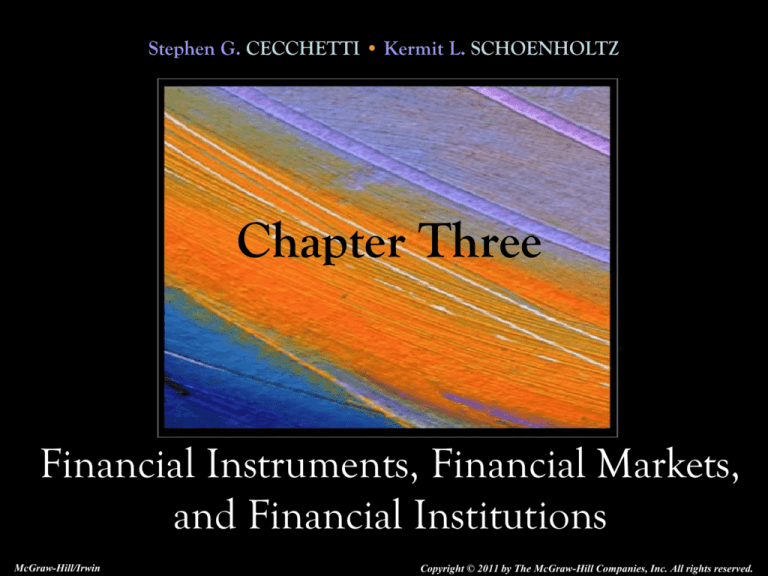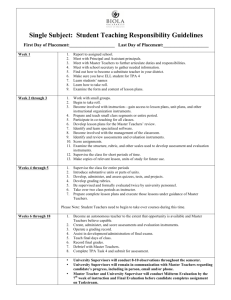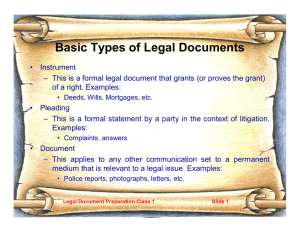
Stephen G. CECCHETTI • Kermit L. SCHOENHOLTZ
Chapter Three
Financial Instruments, Financial Markets,
and Financial Institutions
McGraw-Hill/Irwin
Copyright © 2011 by The McGraw-Hill Companies, Inc. All rights reserved.
Introduction
• The international financial system exists to
facilitate the design, sale, and exchange of a
broad set of contracts with a very specific set
of characteristics.
• We obtain financial resources through this
system:
• Directly from markets, and
• Indirectly through institutions.
3-2
Introduction
•
Indirect Finance: An institution stands between lender
and borrower.
•
•
Direct Finance: Borrowers sell securities directly to
lenders in the financial markets.
•
•
•
We get a loan from a bank or finance company to buy a car.
Direct finance provides financing for governments and
corporations.
Asset: Something of value that you own.
Liability: Something you owe.
3-3
Figure 3.1: Funds Flowing through the
Financial System
3-4
Introduction
• Financial development is linked to economic
growth.
• The role of the financial system is to facilitate
production, employment, and consumption.
• Resources are funneled through the system so
resources flow to their most efficient uses.
3-5
Introduction
We will survey the financial system in three
steps:
1. Financial instruments or securities
•
•
Stocks, bonds, loans and insurance.
What is their role in our economy?
2. Financial Markets
•
•
New York Stock Exchange, Nasdaq.
Where investors trade financial instruments.
3. Financial institutions
•
What they are and what they do.
3-6
Financial Instruments
Financial Instruments: The written legal
obligation of one party to transfer something of
value, usually money, to another party at some
future date, under certain conditions.
• The enforceability of the obligation is important.
• Financial instruments obligate one party (person,
company, or government) to transfer something to
another party.
• Financial instruments specify payment will be made
at some future date.
• Financial instruments specify certain conditions
under which a payment will be made.
3-7
Uses of Financial Instruments
• Three functions:
• Financial instruments act as a means of payment (like money).
• Employees take stock options as payment for working.
• Financial instruments act as stores of value (like money).
• Financial instruments generate increases in wealth that are larger
than from holding money.
• Financial instruments can be used to transfer purchasing power
into the future.
• Financial instruments allow for the transfer of risk (unlike money).
• Futures and insurance contracts allows one person to transfer risk
to another.
3-8
• The use of borrowing to finance part of an
investment is called leverage.
• Leverage played a key role in the financial crisis of
2007-2009.
• How did this happen?
• The more leverage, the greater the risk that an
adverse surprise will lead to bankruptcy.
• The more highly leveraged, the less net worth.
3-9
• How did this happen? (cont.)
• Some important financial institutions, during the
crisis, were leveraged at more than 30 times their
net worth.
• When losses are experienced, firms try to
deleverage to raise net worth.
• When too many institutions deleverage, prices
fall, losses increase, net worth falls more.
• This is called the “paradox of leverage”.
3-10
• The “paradox of leverage” reinforces the
destabilizing liquidity spiral from Chapter 2.
• Both spirals feed the cycle of falling prices and
widespread deleveraging that was the hallmark
of the financial crisis of 2007-2009.
3-11
Characteristics of Financial
Instruments
• These contracts are very complex.
• This complexity is costly, and people do not
want to bear these costs.
• Standardization of financial instruments
overcomes potential costs of complexity.
• Most mortgages feature a standard application with
standardized terms.
3-12
Characteristics of Financial
Instruments
• Financial instruments also communicate
information, summarizing certain details about
the issuer.
• Continuous monitoring of an issuer is costly and
difficult.
• Mechanisms exist to reduce the cost of
monitoring the behavior of counterparties.
• A counterparty is the person or institution on the
other side of the contract.
3-13
Characteristics of Financial
Instruments
• The solution to high cost of obtaining
information is to standardize both the
instrument and the information about the
issuer.
• Financial instruments are designed to handle
the problem of asymmetric information.
3-14
Underlying Versus Derivative
Instruments
• Two fundamental classes of financial
instruments.
• Underlying instruments are used by savers/lenders
to transfer resources directly to investors/borrowers.
• This improves the efficient allocation of
resources.
• Examples: stocks and bonds.
3-15
Underlying Versus Derivative
Instruments
• Derivative instruments are those where their
value and payoffs are “derived” from the
behavior of the underlying instruments.
• Examples are futures and options.
• The primary use is to shift risk among investors.
3-16
A Primer for Valuing Financial
Instruments
Four fundamental characteristics influence the value of a
financial instrument:
1. Size of the payment:
•
Larger payment - more valuable.
2. Timing of payment:
•
Payment is sooner - more valuable.
3. Likelihood payment is made:
•
More likely to be made - more valuable.
4. Conditions under with payment is made:
•
Made when we need them - more valuable.
3-17
A Primer for Valuing Financial
Instruments
We organize financial instruments by how they
are used:
• Primarily used as stores of value
1. Bank loans
• Borrower obtains resources from a lender to be
repaid in the future.
2. Bonds
• A form of a loan issued by a corporation or
government.
• Can be bought and sold in financial markets.
3-18
A Primer for Valuing Financial
Instruments
3.
Home mortgages
• Home buyers usually need to borrow using the
home as collateral for the loan.
•
4.
A specific asset the borrower pledges to protect the
lender’s interests.
Stocks
• The holder owns a small piece of the firm and
entitled to part of its profits.
• Firms sell stocks to raise money.
• Primarily used as a stores of wealth.
3-19
A Primer for Valuing Financial
Instruments
5.
Asset-backed securities
• Shares in the returns or payments arising from
specific assets, such as home mortgages and
student loans.
• Mortgage backed securities bundle a large
number of mortgages together into a pool in
which shares are sold.
•
Securities backed by sub-prime mortgages played an
important role in the financial crisis of 2007-2009.
3-20
A Primer for Valuing Financial
Instruments
Primarily used to Transfer Risk
1.
Insurance contracts.
• Primary purpose is to assure that payments
will be made under particular, and often rare,
circumstances.
2. Futures contracts.
• An agreement between two parties to
exchange a fixed quantity of a commodity or
an asset at a fixed price on a set future date.
• A price is always specified.
• This is a type of derivative instrument.
3-21
A Primer for Valuing Financial
Instruments
3.
•
Options
• Derivative instruments whose prices are based
on the value of an underlying asset.
• Give the holder the right, not obligation, to
buy or sell a fixed quantity of the asset at a
pre-determined price on either a specific date
or at any time during a specified period.
These offer an opportunity to store value and
trade risk in almost any way one would like.
3-22
• The biggest risk we all face is becoming
disabled and losing our earning capacity.
• Insuring against this should be one of our highest
priorities.
• More likely than our house burning down.
• It is important to assess to make sure you have
enough insurance.
• One risk better transferred to someone else.
3-23
Financial Markets
• Financial markets are places where financial
instruments are bought and sold.
• These markets are the economy’s central
nervous system.
• These markets enable both firms and
individuals to find financing for their activities.
• These markets promote economic efficiency:
• They ensure resources are available to those who
put them to their best use.
• They keep transactions costs low.
3-24
The Role of Financial Markets
1. Liquidity:
•
•
Ensure owners can buy and sell financial
instruments cheaply.
Keeps transactions costs low.
2. Information:
•
Pool and communication information about issuers
of financial instruments.
3. Risk sharing:
•
Provide individuals a place to buy and sell risk.
3-25
The Structure of Financial Markets
1. Distinguish between markets where new
financial instruments are sold and where they
are resold or traded: primary or secondary
markets.
2. Categorize by the way they trade: centralized
exchange or not.
3. Group based on the type of instrument they
trade: as a store of value or to transfer risk.
3-26
Primary versus Secondary Markets
• A primary market is one in which a borrower
obtains funds from a lender by selling newly
issued securities.
• Occurs out of the public views.
• An investment bank determines the price, purchases
the securities, and resells to clients.
• This is called underwriting and is usually very
profitable.
3-27
Primary versus Secondary Markets
• Secondary financial markets are those where
people can buy and sell existing securities.
• Buying a share of IBM stock is not purchased from
the company, but from another investor in a
secondary market.
• These are the prices we hear about in the news.
3-28
Centralized Exchanges, OTC’s, and
ECN’s
• Centralized exchanges - buyers and sellers
meet in a central, physical location.
• Over-the-counter markets (OTS’s) decentralized markets where dealers stand
ready to buy and sell securities electronically.
• Electronic communication networks (ECN’s) electronic system bringing buyers and sellers
together without the use of a broker or dealer.
3-29
Centralized Exchanges, OTC’s, and
ECN’s
• History
• The New York Stock Exchange (NYSE) is a place
with an address where trading takes place in person
on the floor of the exchange.
• A firm purchases a license issued by the
Exchange.
• Others were acquired by specialists who
oversaw the trading.
3-30
Centralized Exchanges, OTC’s, and
ECN’s
• History (cont.)
• In the past, the only alternative was an OTC market.
• Networks of physically dispersed dealers, who
buy and sell electronically.
• The largest is the Nasdaq.
• In 2005, the NYSE merged with Archipelago (now
NYSE Arca), and Nasdaq merged with Instinet.
3-31
Centralized Exchanges, OTC’s, and
ECN’s
• History (cont.)
• Market continues to globalize.
• In 2007, the NYSE merged with Paris-based
Euronext becoming the first international operator
of major exchanges.
• Nasdaq attempted to acquire the London Stock
Exchange but dropped its bid in 2007 right before
the financial crisis.
3-32
• Trading is what makes financial markets work.
• Placing an order in a stock market has the
following characteristics:
•
•
•
•
The stock you wish to trade.
Whether you wish to buy or sell.
The size of the order - number of shares.
The price you would like to trade.
3-33
• You can place a market order.
• Your order is executed at the most favorable price
currently available.
• Values speed over price.
• You can place a limit order:
• Places a maximum on the price to buy or a
minimum price to sell.
3-34
• Executing a trade requires someone on the
other side.
• Broker
• Direct access to electronic trading network through
an ECN like Acra or Instinet.
• Customer orders interact automatically without
an intermediary.
• Liquidity is provided by customers.
3-35
• For a well known stock, the NYSE is another
place from which to order.
• Liquidity is supplemented by designated market
makers (DMMs).
• The person on the floor charged with making a
market.
• To make the market work, they often buy and
sell on their own account.
3-36
Debt and Equity versus Derivative
Markets
• Used to distinguish between markets where
debt and equity are traded and those where
derivative instruments are traded.
• Equity markets are the markets for stocks.
• Derivative markets are the markets where
investors trade instruments like futures and
options.
3-37
Debt and Equity versus Derivative
Markets
• In debt and equity markets, actual claims are
bought and sold for immediate cash payments.
• In derivative markets, investors make
agreements that are settled later.
• Debt instruments categorized by the loan’s
maturity
• Repaid in less than a year - traded in money
markets.
• Maturity of more than a year - traded in bond
markets.
3-38
• This article highlights large swings in financial
markets during the financial crisis from 20072009.
• Before the crisis, professional investors made
their own institutions and the overall financial
system vulnerable by taking on too much risk.
• When the crisis hit, they faced a shortfall of
liquidity.
• Liquidity swings caused many financial
markets to plunge and rebound together.
3-39
3-40
Characteristics of a Well-Run
Financial Market
• Essential characteristics of a well-run financial
market:
• Must be designed to keep transaction costs low.
• Information the market pools and communicates
must be accurate and widely available.
• Borrowers promises to pay lenders much be
credible.
3-41
Characteristics of a Well-Run
Financial Market
• Because of these criteria, the governments are
an essential part of financial markets as they
enforce the rules of the game.
• Countries with better investor protections have
bigger and deeper financial markets.
3-42
• Liquid, interbank loans are the marginal source
of funds for many banks, with their cost
guiding other lending rates.
• The financial crisis of 2007-2009 strained
interbank lending.
• Anxious banks preferred to hold their liquid assets
in case their own needs arose.
• They also were concerned about the safety of their
trading partners.
3-43
• The rising cost and reduced availability of
interbank loans created a vicious circle of:
•
•
•
•
increased caution,
greater demand for liquid assets,
reduced willingness to lend, and
higher loan rates.
3-44
3-45
Financial Institutions
• Firms that provide access to the financial markets, both
• to savers who wish to purchase financial instruments directly
and
• to borrowers who want to issue them.
• Also known as financial intermediaries.
• Examples: banks, insurance companies, securities firms, and
pension funds.
• Healthy financial institutions open the flow of
resources, increasing the system’s efficiency.
3-46
The Role of Financial Institutions
• To reduce transaction costs by specializing in
the issuance of standardized securities.
• To reduce the information costs of screening
and monitoring borrowers.
• They curb asymmetries, helping resources flow to
most productive uses.
• To give savers ready access to their funds.
3-47
• Financial intermediation and leverage in the
US have shifted away from traditional banks
and toward other financial institutions less
subject to government regulations.
• Brokerages, insurers, hedge funds, etc.
• These have become known as shadow banks.
• Provide services that compete with banks but do not
accept deposits.
• Take on more risk than traditional banks and are
less transparent.
3-48
• The rise of highly leveraged shadow banks,
combined with government relaxation of rules
for traditional banks, permitted a rise of
leverage in the financial system as a whole.
• This made the financial system more vulnerable to
shocks.
• Rapid growth in some financial instruments
made it easier to conceal leverage and risktaking.
3-49
• The financial crisis transformed shadow
banking.
• The largest US brokerages failed, merged, or
converted themselves into traditional banks to gain
access to funding.
• The crisis has encouraged the government to
scrutinize any financial institution that could,
by risk taking, pose a threat to the financial
system.
3-50
The Structure of the Financial
Industry
• We can divide intermediaries into two broad
categories:
• Depository institutions,
• Take deposits and make loans
• What most people think of as banks
• Non-depository institutions.
• Include insurance companies, securities firms,
mutual fund companies, etc.
3-51
The Structure of the Financial
Industry
1. Depository institutions take deposits and
make loans.
2. Insurance companies accept premiums, which
they invest, in return for promising
compensation to policy holders under certain
events.
3. Pension funds invest individual and company
contributions in stocks, bonds, and real estate
in order to provide payments to retired
workers.
3-52
The Structure of the Financial
Industry
4. Securities firms include brokers, investment
banks, underwriters, and mutual fund
companies.
•
•
•
Brokers and investment banks issue stocks and
bonds to corporate customers, trade them, and
advise customers.
Mutual-fund companies pool the resources of
individuals and companies and invest them in
portfolios.
Hedge funds do the same for small groups of
wealthy investors.
3-53
The Structure of the Financial
Industry
5. Finance companies raise funds directly in the
financial markets in order to make loans to
individuals and firms.
•
Finance companies tend to specialize in particular
types of loans, such as mortgage, automobile, or
business equipment.
3-54
The Structure of the Financial
Industry
6. Government-sponsored enterprises are
federal credit agencies that provide loans
directly for farmers and home mortgagors.
•
•
Guarantee programs that insure loans made by
private lenders.
Provides retirement income and medical care
through Social Security and Medicare.
3-55
Figure 3.2: Flow of Funds through
Financial Institutions
3-56
• Most people need to borrow to buy a house.
• Mortgage payment will be your biggest
monthly expense so shop around.
• Many offers are from mortgage brokers - firms
that have access to pools of funds earmarked
for use as mortgages.
• Who offers your mortgage is not important get the best rate you can.
3-57
Stephen G. CECCHETTI • Kermit L. SCHOENHOLTZ
End of
Chapter Three
Financial Instruments, Financial Markets,
and Financial Institutions
McGraw-Hill/Irwin
Copyright © 2011 by The McGraw-Hill Companies, Inc. All rights reserved.








